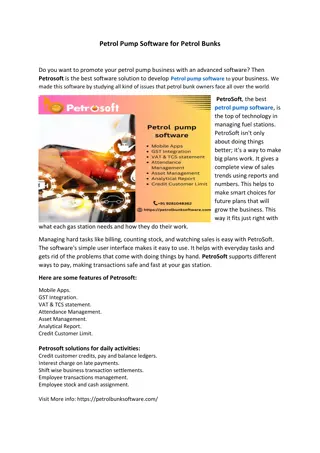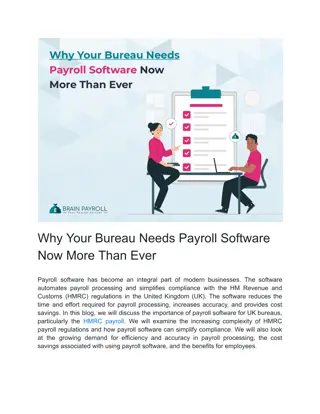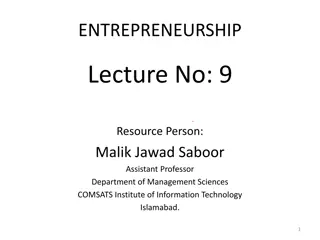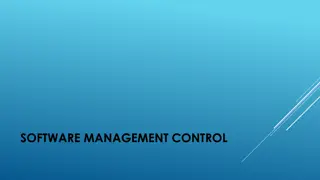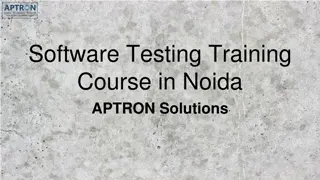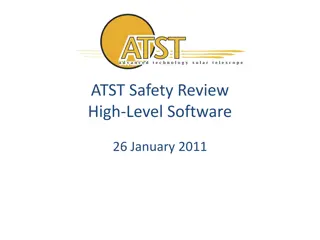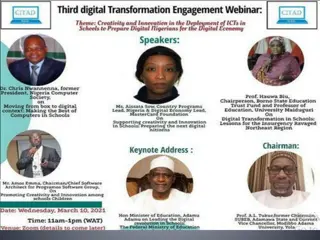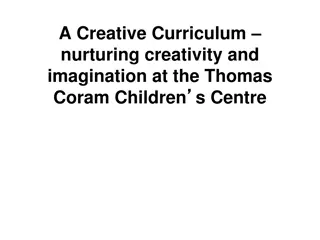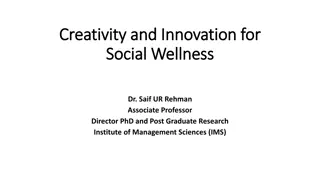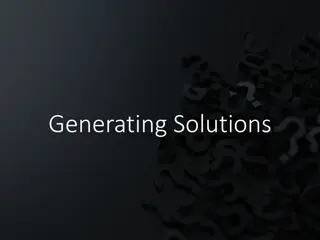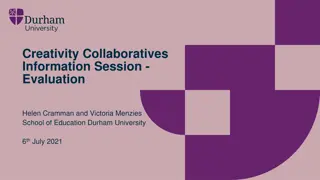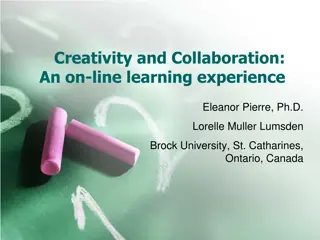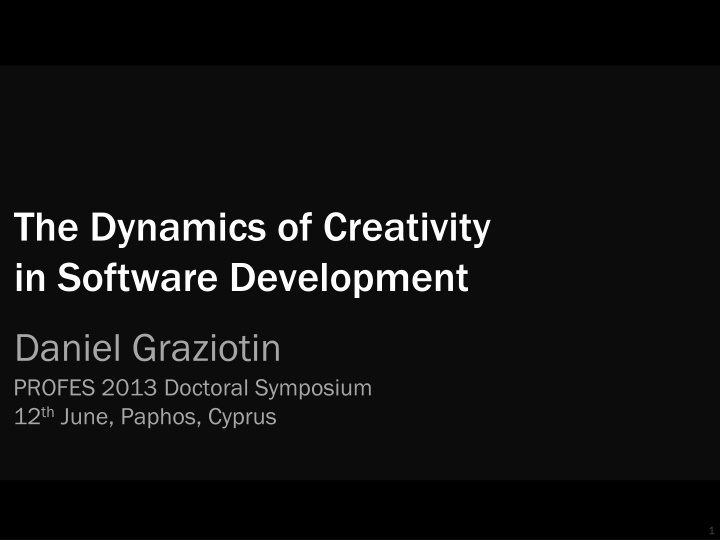
Dynamics of Creativity in Software Development - Insights from Daniel Graziotin
Explore the intersection of creativity, emotions, and productivity in software development through the research of Daniel Graziotin. Learn how human factors impact the software engineering process and why focusing on people is key to success.
Download Presentation

Please find below an Image/Link to download the presentation.
The content on the website is provided AS IS for your information and personal use only. It may not be sold, licensed, or shared on other websites without obtaining consent from the author. If you encounter any issues during the download, it is possible that the publisher has removed the file from their server.
You are allowed to download the files provided on this website for personal or commercial use, subject to the condition that they are used lawfully. All files are the property of their respective owners.
The content on the website is provided AS IS for your information and personal use only. It may not be sold, licensed, or shared on other websites without obtaining consent from the author.
E N D
Presentation Transcript
The Dynamics of Creativity in Software Development Daniel Graziotin PROFES 2013 Doctoral Symposium 12th June, Paphos, Cyprus 1
Introduction Background, Motivation, Purposes 1 Literature Review Creativity, Affective States, Improvisation, Research Questions 2 Research Methodology Theory Building, Data Analysis, Theory Representation 3 Conclusion What is next 4 2
Daniel Graziotin Background Researcher Human Factors in SE - Emotions / Moods - Creativity - Productivity - Web Engineering - Open{Source, Access, Data} - 3
Daniel Graziotin Background Practitioner Web Development Open Source Software Open Knowledge task3.cc 4
Daniel Graziotin Background Stuff Singer Electric Bass 5
Programming [..] gratifies creative longings [..] and delights sensibilities we have in common with all men. Frederick P. Brooks, Jr. The Mythical Man-Month, p. 8 6
Software is for People, by People Human Factors must be studied (Crawford et al. , 2012). Process 7
People Trump Process? (Cockburn, 2001) Picture Credits 8
Focus on People Picture Credits 9
Focus on People Picture Credits 10
Software Development is Cognitive (Khan et al., 2010) Creativity Emotions / Moods Improvisation Picture Credits 11
Software Engineering ignores Creativity misconception Emotions/Moods ignored Improvisation neglected Picture Credits 12
Purposes of this Study Definition Software Creativity Dynamics Development Influence 13 Generate a theory
Introduction Background, Motivation, Purposes 1 Literature Review Creativity, Affective States, Improvisation, Research Questions 2 Research Methodology Theory Building, Data Analysis, Theory Representation 3 Conclusion What is next 4 14
Literature Review Defining Creativity Hundreds of Definitions in Psychology Product/Idea Generation (evaluation?) Novelty Usefulness 15
Literature Review Defining Creativity Definitions limited for the context of Software Development Pre-implementation phases Final Product 16
Literature Review Creativity in Software Engineering Gu and Tong, 2004, exploratory research. Software Project developed by students Measurements: Perceived creative time, perceived discipline-based time, and other time. Formulated Hypotheses: Implementation phase most creative, Post-mortem analysis phase least creative; UML documentation promotes students to do more creative work in requirement specification and architecture design phases; more creative work does neither accelerate nor decelerate development speed compared with discipline-based work; developers prefer development phases including more creative work than discipline-based work 17
Literature Review Creativity in Software Engineering Crawford et al., 2012 Previous research on creativity focused on RE Techniques to foster creativity are rarely investigated Linkage between eXtreme Programming and Creative Thinking 18
Literature Review Creativity in Software Engineering Several proposals to foster creativity in software requirements Evaluation is always in terms of the generated product Requirements look like ideas 19
Literature Review Creativity in Psychology More than 60 years of studies Angles Product, Process, Person, and Press Majority of studies on Product (novelty and value) Affective States 20
Literature Review Creativity and Affective States in Psychology Affective States (Mood, Emotions, Feelings) one of the most widely studied and least disputed predictors of creativity (Davis, 2009) Several Studies Tendency: extreme affective states indicate higher creativity No big consensus 21
Literature Review Improvisation Making sense of incoming working events and developing ad- hoc solutions (Ciborra, 1996) Problem-setting and problem-solving Creative Do we always follow the process? We report to follow the process We improvise Essential to IT firms Improvisation is a mood 22
Improvisation, Creativity, Affective States Creativity Improvisation ? Affective States 23
Research Questions Is there a misconception of creativity in the context of software development? What are the key components of creativity in software development at the individual, team, and organizational levels? What is the relationship between creativity, moods, and improvisation in software development? 24
Introduction Background, Motivation, Purposes 1 Literature Review Creativity, Affective States, Improvisation, Research Questions 2 Research Methodology Theory Building, Data Analysis, Theory Representation 3 Conclusion What is next 4 25
Research Methodology AIMS Explorative study Generate a theory from empirical evidence. Define the steps of the theory building process Select a strategy to analyze the data Represent the theory in a meaningful way Choose research methods 26
Theory Building Phases Eisenhardt, 1989 1 5 Research Questions Data Analysis 2 Hypotheses Shaping 6 Case Selection 7 Instruments & Protocols3 Literature Enfolding 4 8 Field Entrance Closure Reaching 27
Data Analysis Phases Montoni & Rocha (2010), Charmaz (2006) Context & Scope Data Collection Coding Audit Validity Open Surveys Overlaps with Step 1 of previous slide Conceptualization Literature Reviews Axial Structured and semi- structured interviews Relationships Selective Prioritization 28
Theory Representation Sj berg et al., 2008 Elements of a theory Constructs Propositions Explanations Scope Sj berg et al., 2008, p. 324 29
Introduction Background, Motivation, Purposes 1 Literature Review Creativity, Affective States, Improvisation, Research Questions 2 Research Methodology Theory Building, Data Analysis, Theory Representation 3 Conclusion What is next 4 30
Conclusion Proposal: generate theory on creativity in software development Creativity, Affective States, Improvisation Major issue: still no focus. 31
Thank you for your attention Daniel Graziotin daniel.Graziotin@unibz.it 32
References Brooks, F.P.: The Mythical Man-Month. Addison-Wesley, Philippines (1975) Ciborra, C.: Improvisation and information technology in organizations. ICIS 1996. p. 26 (1996). Charmaz, K.: Constructing grounded theory: a practical guide through qualitative analysis. Sage Publications, London (2006). Crawford, B. et al.: Agile software teams must be creatives. 5th International Workshop on Co-operative and Human Aspects of Software Engineering. pp. 20 26 (2012). Davis, M.: Understanding the relationship between mood and creativity: A meta-analysis. Organizational Behavior and Human Decision Processes. 108, 1, 25 38 (2009). Dyb , T.: Improvisation in small software organizations. Software, IEEE. September/October, 82 87 (2000). Eisenhardt, K.: Building theories from case study research. Academy of management review. 14, 4, 532 550 (1989). Gu, M., Tong, X.: Towards Hypotheses on Creativity in Software Development. 5th International Conference on Product Focused Software Process Improvement,. pp. 47 61, (2004). Khan, I.A. et al.: Do moods affect programmers debug performance? Cognition, Technology & Work. 13, 4, 245 258 (2010). Montoni, M.A., Rocha, A.R.: Applying Grounded Theory to Understand Software Process Improvement Implementation. 7th International Conference on the Quality of Information and Communications Technology. pp. 25 34 IEEE (2010). Sj berg, D. et al.: Building theories in software engineering. Guide to Advanced Empirical Software Engineering. 1, 1, 312 336 (2008). 33


